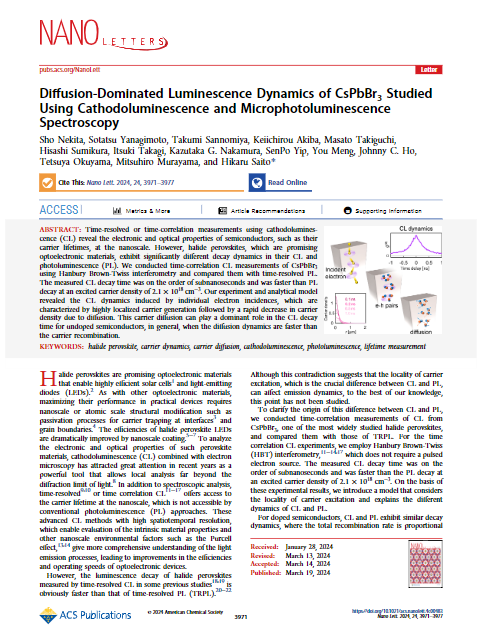Time-resolved or time-correlation measurements using cathodoluminescence (CL) reveal the electronic and optical properties of semiconductors, such as their carrier lifetimes, at the nanoscale. However, halide perovskites, which are promising optoelectronic materials, exhibit significantly different decay dynamics in their CL and photoluminescence (PL). We conducted time-correlation CL measurements of CsPbBr3 using Hanbury Brown-Twiss interferometry and compared them with time-resolved PL. The measured CL decay time was on the order of subnanoseconds and was faster than PL decay at an excited carrier density of 2.1 × 1018 cm–3. Our experiment and analytical model revealed the CL dynamics induced by individual electron incidences, which are characterized by highly localized carrier generation followed by a rapid decrease in carrier density due to diffusion. This carrier diffusion can play a dominant role in the CL decay time for undoped semiconductors, in general, when the diffusion dynamics are faster than the carrier recombination.
Sho Nekita Sho Nekita Interdisciplinary Graduate School of Engineering Sciences, Kyushu University, 6-1 Kasugakoen, Kasuga, Fukuoka 816-8580, Japan More by Sho Nekita , Sotatsu Yanagimoto, Takumi Sannomiya, Keiichirou Akiba, Masato Takiguchi, Hisashi Sumikura, Itsuki Takagi, Kazutaka G. Nakamura, SenPo Yip, You Meng, Johnny C. Ho, Tetsuya Okuyama, Mitsuhiro Murayama, and Hikaru Saito*
Diffusion-Dominated Luminescence Dynamics of CsPbBr3 Studied Using Cathodoluminescence and Microphotoluminescence Spectroscopy
Nano Letters, 2024, 24, 13, 3971–3977
2024.04.11
関連リンク
